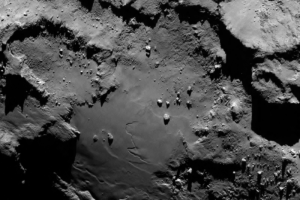
A University planetary scientist is part of an international team that has established the first direct link between collapsing structures on comets and cometary outbursts.
Dr Stephen Lowry, Reader in Planetary and Space Sciences at the University’s School of Physical Sciences, was part of a team of scientists to author a new paper on the results of a change on the surface of the comet 67P/Churyumov-Gerasimenko.
The team found that a large cliff known as Aswan collapsed on the surface of the comet, producing a plume of dust material from the surface and revealing a fresh patch of the interior of the comet.
Following the collapse of the Aswan cliff, the pristine sub-surface material of the comet could be observed and studied for the first time.
Dr Lowry is part of the team behind the main camera instrument on Rosetta, the European Space Agency spacecraft that explored the comet. The spacecraft visited the comet for two and a half years and eventually settled on its surface in September 2016.
The mission has changed scientists understanding of comets and how they formed, and analysis of the data is continuing.
Dr Lowry explained that ‘careful analysis of the light reflected off this area showed that it is composed mainly of water ice, which gradually sublimated (converted directly from solid ice to gas) over subsequent months, and eventually the exposed area was indistinguishable from the surrounding material. This transition has never been seen before’.
Computer simulations were used to study how the Aswan cliff was heated by the Sun during the months surrounding the event. It was seen that the top of the cliff (the plateau) and the cliff wall experience very different solar-illumination patterns during this time, which causes fractures to form into the comet due to thermal stresses. This leads to collapse of material, forming a dust ‘outburst’.
According to Dr Lowry, this represented ‘the first direct link between collapsing structures on comets and cometary outbursts’, which explained ‘the presence of dusty layers and boulder fields on comet surfaces’.
The paper ‘The pristine interior of comet 67P revealed by the combined Aswan outburst and cliff collapse’ is published in the journal Nature Astronomy (Pajola, M. et al. Nat. Astron. 1, 0092 (2017)).